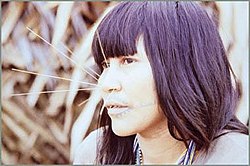
Matsés
 | |
| Total population | |
|---|---|
| approx. 3,200 (various post-2000 est.) | |
| Regions with significant populations | |
| Matsés Indigenous Reserve: approx. 2,000 | |
| Languages | |
| Matsés, many also speak Spanish or Portuguese. | |
| Religion | |
| Christian, Animist | |
| Related ethnic groups | |
| Matis, Korubo |
The Matsés or Mayoruna are an indigenous people of the Peruvian and Brazilian Amazon. Their traditional homelands are located between the Javari and Galvez rivers. The Matsés have long guarded their lands from other indigenous tribes and struggle with encroachment from illegal logging practices and poaching.

The approximately 3,200 Matsés people speak the Matsés language which belongs to the Panoan language family. In the last thirty years, they have become a largely settled people living mostly in permanent forest settlements. However, they still rely on hunting and gathering for most of their subsistence. Their main source of income comes from selling peccary hides and meat.[citation needed]

Name
The word Matsés comes from the word for "people" in the Matsés language. They are also known as the Mayoruna. The name Mayoruna comes from the Quechua (Runa Simi) language and means "river people." In Brazil the Matsés people are generally referred to as Mayorunas, while in Peru they are usually called Matsés.

Technology
The Matsés have an elaborate knowledge of the plant and animal life of the surrounding rainforest. Little is imported into the Matsés communities and most of what they need for survival comes from the rainforest. Traditionally, they hunted with bows and arrows.

Culture
Their cuisine includes the sweet plantain beverage chapo.

Worldview
In the animist Matsés worldview, there is no distinction between the physical and spiritual worlds, and spirits are present throughout the world. The Matsés believe that animal spirits determine health and success in hunting. They are careful not to offend animal spirits, and have many taboos for hunting different animal species.

Plants, especially trees, hold a complex and important interest for the Matsés. Each plant is associated with an animal spirit. When a plant product is used as a medicine, it is typically applied externally, and the shaman talks to the animal spirit associated with that plant.

Weapons
Bows and arrows are the main weapons of the Matsés culture, although they are currently rarely used in personal conflict. Generally they are only used for hunting animals. The Matsés were never known to use war clubs as do the neighboring Korubo. Historically, they used blowguns, similar to the Matis tribe of Brazil; however, they recently abandoned blowguns in favor of bows and arrows.

Marriage
Matsés families often practice polygamy. Cross-cousin marriages are most common. Marriages are primarily between cousins, with a man marrying the daughter of his father's sister (his aunt).

Recent history
The Matsés made their first permanent contact with the outside world in 1969 when they accepted SIL missionaries into their communities. Before that date, they were effectively at-war with the Peruvian government, which had bombed their villages with napalm and sent the Peruvian army to invade their communities to counter Matsés raids on villages to kidnap women for the tribe.[1] At present, relations between the Matsés and the Peruvian government are peaceful. Dan James Pantone and Bjorn Svensson described the Matsés first peaceful contact with the outside world in an article in Native Planet.[2] In their article, James and Svensson described the 1969 encounter between the Matsés with SIL linguists Harriet Fields and Hattie Kneeland. That same year, 1969, photojournalist Loren McIntyre made contact with the Matsés as described in Petru Popescu's book Amazon Beaming.[3][4][5]

Indigenous political reorganization
The Matsés are very divided and politically unorganized. Each village has its own chief and there is little centralized authority for the tribe. Lack of political organization has made it difficult for the Matsés people to obtain medical assistance from the outside world.

Land rights
The Matsés have title to the Matsés Indigenous Reserve that was established in 1998. The reserve measures 457000 ha. Despite having title to their own reserve, living conditions for the Matsés have deteriorated. According to a 2006 article in Cultural Survival Quarterly by Dan James Pantone, living conditions have become much worse, to the point that the very survival of the Matsés people is in jeopardy.[6] At present,[when?] there is a proposal to expand the Matsés Communal Reserve to give the Matsés people control over their traditional hunting grounds.

Logging controversy
In September 2013, the Matsés chief announced plans to start logging the Matsés Native Community lands and rejected oppositions of environmental organisations which he claimed were manipulating Matsés students.[7] In response, Matsés students claimed that the chief was being manipulated by loggers and demanded that the Matsés chief be removed for not defending the interests of his people.[8]

Municipality corruption
To make matters more complex for the Matsés people, in September 2013 the Matsés mayor (Andres Rodriquez Lopez) of the Yaquerana District was publicly accused of corruption by the municipal regulators who blocked his ability to use the municipal checking account.[9] The municipality where the Matsés live has had a history of fraud and the ex-mayor, Helen Ruiz Torres, was sentenced to six years in jail for embezzling municipal funds.[10]

Conservation Efforts
Acaté Amazon Conservation
Acaté Amazon Conservation is a non-profit that was founded in 2013, but existed since 2006 as a loose organization of its founders, Christopher Herndon, MD, and William Park. Acaté operates projects in the Peruvian Amazon rainforest, and integrates culture, health, and ecology into all of its projects. Its current projects include documenting and preserving the indigenous medicinal knowledge of the Matsés by completing the first traditional medicine encyclopedia written in the Matsés language, resiliency projects / programs utilizing permaculture techniques, and providing the Matsés economic opportunities with renewable non-timber natural products.[11]

See also
- Nu-nu, a snuff used by Matsés men
References
- ^ Snell, Ron (2 February 2006). Jungle Calls (Kindle ed.). Garland, Texas: Hannibal Books. ISBN 0-929292-86-3. Retrieved 27 May 2020.
- ^ Pantone, Dan James; Svensson, Bjorn. "Matsés First Contact: The end of isolation" (PDF). Native Planet.
- ^ Abrams, Garry (8 November 1991). "Adventures on the Amazon : After Years of Silence, Explorer Loren McIntyre Recounts His Harrowing Journey to Reach the River's Source". Los Angeles Times. Los Angeles Times. Retrieved 26 May 2020.
- ^ Stochlic, Nina (November 2016). "A Forgotten Adventure With a Telepathic Tribe". National Geographic. National Geographic Society. The Walt Disney Company. Archived from the original on March 30, 2017. Retrieved 25 May 2020.
- ^ Wagner, Loren (7 January 2020). "Loren McIntyre Telepathically Communicated with This Amazon Tribe". Gaia. Jirka Rysavy. Retrieved 26 May 2020.
- ^ "A Forest of Their Own". www.culturalsurvival.org. 26 May 2010. Retrieved 2020-05-07.
- ^ "Rechaza manipulación de organizaciones ambientalistas con estudiantes…". archive.is (in Spanish). 2013-09-26. Archived from the original on 2013-09-26. Retrieved 2020-05-07.
- ^ ""En 15 días viajaré para que muestren documentos de los permisos para sacar madera" | Diario de Noticias y Actualidad de Loreto - Iquitos - Ucayali - Requena - Datem del Marañon - Mariscal Ramon Castilla - Alto Amazonas - Loreto - Maynas - El Diario Judicial de Loreto" (in Spanish). 2013-09-13. Archived from the original on 2013-09-13. Retrieved 2020-05-07.
- ^ "Regidores acuerdan bloquear cuentas corrientes que maneja la Municipalidad | Diario de Noticias y Actualidad de Loreto - Iquitos - Ucayali - Requena - Datem del Marañon - Mariscal Ramon Castilla - Alto Amazonas - Loreto - Maynas - El Diario Judicial de Loreto" (in Spanish). 2014-07-14. Archived from the original on 2014-07-14. Retrieved 2020-05-07.
- ^ "II Sala Penal ve caso sobre pago de dietas a regidores de Yaquerana | Diario de Noticias y Actualidad de Loreto - Iquitos - Ucayali - Requena - Datem del Marañon - Mariscal Ramon Castilla - Alto Amazonas - Loreto - Maynas - El Diario Judicial de Loreto" (in Spanish). 2014-07-14. Archived from the original on 2014-07-14. Retrieved 2020-05-07.
- ^ "Amazon tribe creates 500-page traditional medicine encyclopedia". Mongabay Environmental News. 2015-06-24. Retrieved 2020-05-07.
- Romanov S., D.M. Huanan, F.S. Uaqui, and D.W. Fleck. The Traditional Life of the Matsés. CAAAP Press: Lima, Peru. 148 pp.
External links
Additional Resources
- Herbermann, Charles, ed. (1913). . Catholic Encyclopedia. New York: Robert Appleton Company.
- New Amazonian reserve saves over a million acres in Peru
- Mayoruna art, National Museum of the American Indian
- Matsés Indigenous Traditions
See what we do next...
OR
By submitting your email or phone number, you're giving mschf permission to send you email and/or recurring marketing texts. Data rates may apply. Text stop to cancel, help for help.
Success: You're subscribed now !
